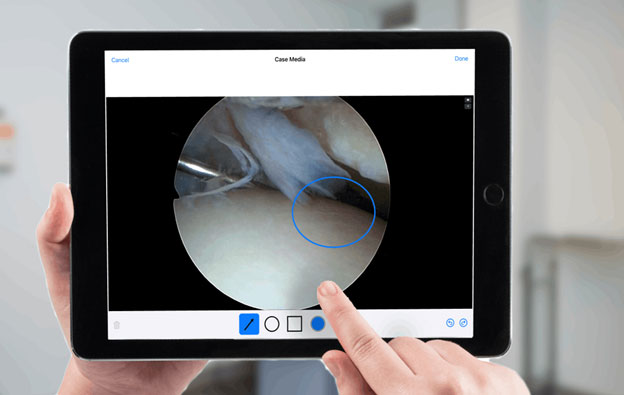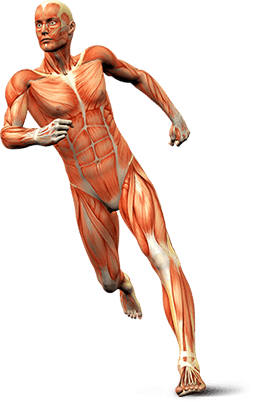Patient Surgery Binder
We are delighted to have you visit our website and provide you with valuable information about your orthopaedic care. Dr. Coyner is committed to delivering exceptional patient experiences and achieving the best possible outcomes for her patients. As part of our commitment to transparency and patient education, we want to take a moment to explain an important aspect of your post-operative journey.
Following your surgery, we understand that you may have questions and a desire to better understand the details of the surgical intervention. That's why we utilize advanced technology and collaboration with Arthrex Synergy to enhance your experience and provide you with comprehensive insights.
Shortly after your surgery, you will receive an email from Synergy SurgeonVault® System, which will include a link to access any arthroscopic photos taken during the procedure and accessible by your date of birth. These photos offer you a visual understanding of the surgical intervention and provide clarity regarding the specific areas addressed. We believe that seeing the images can empower you with knowledge and help you visualize the remarkable work that has been done to improve your orthopaedic health.
Here is an example:

In addition to the arthroscopic photos, the email from Synergy SurgeonVault® System will also contain a direct link to the precise physical therapy (PT) protocol designed for your unique case. This protocol serves as a comprehensive guide to your post-operative rehabilitation, outlining specific exercises, movements, and guidelines tailored to your procedure. By following this PT protocol diligently, you will play an active role in your recovery process and maximize your chances of achieving the best possible outcome.
At Dr. Coyner's practice, we understand that every patient is unique, and we strive to provide personalized care that caters to your specific needs. The combination of arthroscopic photos and the PT protocol link will give you valuable tools to better comprehend your surgical journey and actively participate in your recovery. We want you to feel informed, empowered, and confident as you navigate the healing process.
Please remember that our dedicated team is always available to answer any questions or concerns you may have. We are here to support you every step of the way, ensuring that you have a smooth and successful recovery.
Thank you for choosing Dr. Coyner for your orthopaedic care. We are honored to be part of your journey towards improved health and well-being. If you have any further inquiries or would like to schedule an appointment, please don't hesitate to contact our office.
Wishing you a speedy recovery,
Katherine J Coyner, MD, MBA
Weight Bearing Information
What do I need to know about weight bearing?
What does it mean to have a “weight bearing restriction” after surgery?
A weight bearing restriction is a limitation on the amount of weight or force that you are able to put through your operated leg for a period of time after surgery. This restriction is given by your surgeon in order to allow for proper healing. Knowing your weight bearing status is important so that you can perform activities safely.

Weight Bearing Status: Determined for Your Safety and Mobility
After your surgery, your weight bearing status will be determined by Dr. Coyner based on the specific procedure and your individual needs. This crucial information will be clearly outlined in your printed discharge instructions, which will be provided to you before leaving the hospital. These instructions will serve as your go-to guide, outlining your weight bearing restrictions and providing you with the necessary information to ensure a successful recovery.
Post-Operative Physical Therapy Visit: Your Key to Rehabilitation
In addition to your discharge instructions, your first post-operative physical therapy visit will play a vital role in your recovery process. During this visit, a skilled physical therapist will review your weight bearing status and provide personalized guidance tailored to your unique situation. They will assess your progress, discuss your goals, and design a comprehensive rehabilitation program to optimize your recovery. This dedicated session will empower you to regain your strength, mobility, and independence with confidence.
What are the different weight bearing statuses and what do they mean?
Non-weight bearing:
- Your operated leg must be OFF the floor entirely when walking.
Touch (or toe touch) weight bearing:
- The foot of your operated leg touches the floor, but almost all of your weight is taken through your arms (using an assistive device such as a walker or crutches). Think “If you are walking on soft earth there would be no footprint on it.”
Partial weight bearing:
- 50% - You are allowed to put up to 50% of your weight on your operated leg
- 25% - You are allowed to put up to 25% of your weight on your operated leg
How long does a weight bearing restriction last?
Your weight bearing restriction may be changed or removed by your doctor at any time. It is dependent on your recovery and function. Please ask your Care Team any questions related to your weight bearing restrictions.
General Use of Shoulder Immobilizer After Shoulder Surgery
Introduction:
Welcome to Dr. Coyner’s resource on the general use of a shoulder immobilizer following shoulder surgery. This guide aims to provide you with information on how to properly use and care for your shoulder immobilizer to support your recovery and ensure optimal healing after your surgery. It is important to note that specific instructions may vary based on Dr. Coyner’s recommendations. The restrictions and timeframe will be discussed before surgery, confirmed in your printed discharge instructions and also reviewed at your first physical therapy appointment.
What is a Shoulder Immobilizer?
A shoulder immobilizer is a supportive device designed to limit the movement of your shoulder joint after surgery. It is typically used in the initial stages of your recovery to protect the surgical site, provide stability, and promote healing. The immobilizer consists of straps, a sling, and an adjustable support system to secure your arm and shoulder in a comfortable and safe position.
Wearing the Shoulder Immobilizer:
Positioning: Put on the shoulder immobilizer according to the specific instructions given by your surgeon or physical therapist. The sling should support your forearm, while the straps should secure your arm against your chest. Ensure a snug but not overly tight fit.
Comfort: Adjust the straps and support system to find a position that provides comfort and stability. Avoid excessive pressure points or tightness that could restrict blood circulation or cause discomfort.
Range of Motion: Dr. Coyner may advise on certain allowable movements or restrictions while wearing the immobilizer. Follow their instructions carefully to avoid compromising your surgical site or impeding the healing process.
Sleep Position: You will need to wear the immobilizer while sleeping. Position yourself comfortably with appropriate pillows or supports to maintain the desired shoulder positioning throughout the night.
Hygiene and Care:
Cleaning: Keep your immobilizer clean and dry to prevent infection. Follow any specific cleaning instructions provided by your surgeon or refer to the manufacturer's guidelines. If allowed, you may spot clean the straps or sling as needed.
Skin Care: Regularly inspect your skin for any signs of irritation, redness, or pressure sores. Keep the skin under the immobilizer clean and dry. If you notice any concerns, contact Dr. Coyner’s office for further guidance.
Removing the Immobilizer: Only remove the shoulder immobilizer as advised by Dr. Coyner or the physical therapist. It is crucial to follow their instructions to avoid compromising your surgical site or interfering with the healing process.
Driving: Wearing a shoulder immobilizer is unsafe and potentially illegal. It is strongly advised against engaging in driving activities while wearing a shoulder immobilizer. The restrictions imposed by the immobilizer, such as limited range of motion and reduced control, can impair your ability to safely operate a vehicle. Your focus should be on your own recovery and ensuring the safety of yourself and others on the road.

















